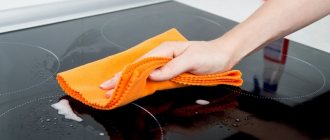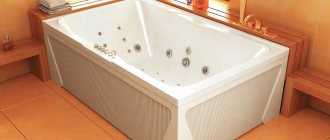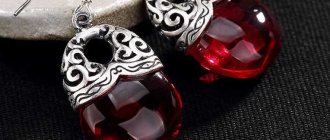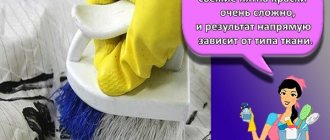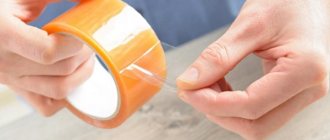Home / Stains
Back
Published: 06/19/2020
Reading time: 13 min
0
8
- 1 General rules for caring for the stove
- 2 Features of glass-ceramic surfaces
- 3 How to clean an electric stove depending on the material
- 4 Special means
- 5 How to clean stove handles and grates
- 6 Cleaning the stove using household chemicals and folk remedies 6.1 Household chemicals
- 6.2 Folk remedies
General rules for stove care
The glass ceramic hob can only be washed after it has completely cooled down. And since water is a good conductor, it is important to disconnect the stove from the power supply.
It is very easy to scratch the stove with abrasive detergents or uneven bottoms of dishes. This can be avoided by following the rules for handling glass ceramics and being careful when choosing cookware for cooking. If you don’t have the opportunity to visit a hardware store and purchase utensils designed for glass-ceramic surfaces, inspect the utensils you already have, mercilessly discarding those that are unsuitable.
Aluminum cookware leaves marks on the surface and is therefore incompatible with glass ceramics. After installing a new stove in the kitchen, it is better to throw away aluminum pans and pots or present them to someone else.
Do not place wet or cold dishes on a hot stove. Such treatment is detrimental to kitchen equipment. The surface of the hob will simply burst. Place pans or pots with a dry bottom on a cold stove before turning it on.
Glass ceramics is a fragile and sensitive material, unstable to sudden temperature changes. Ignoring the above rules will lead to the formation of microcracks and clouding on the surface, followed by more serious damage.
It is extremely undesirable for water to get on the surface of the stove during cooking. Therefore, carefully select lids for pans and pots. Their diameter should not exceed the size of the cookware itself, so that accumulated condensation does not drip onto the surface of the stove.
Limescale deposits formed from drops of water falling on the surface will not be so easy to clean from the stove.
An electric stove is one of the most popular types of large household appliances. It is actively used in apartments, private houses and catering establishments. In order for the device to serve for a long time and be in good condition, you should adhere to the general rules for caring for such equipment:
- Before using the stove, make sure that there are no large contaminants on it in the form of food residues;
- Wipe the hob every time after use;
- cook exclusively in containers that are suitable specifically for your type of electric stove;
- do not allow liquids to come into contact with the burners (if milk has escaped, coffee has escaped, or boiling water has spilled onto the surface, immediately wipe off the dirt with a rag or sponge);
- Do not place pots and pans with wet bottoms on the stove, as they can cause corrosion;
- do not expose the surface to sudden temperature changes, otherwise chips and cracks will form;
- For cooking, use dishes with a flat bottom, this will protect the burners from deformation.
Before you start cleaning the surface of the electric stove, it is worth finding out what is prohibited from doing when caring and operating this device:
- wash hot burners and surfaces, otherwise cracks will form and streaks will appear;
- use wire mesh and metal objects - knives, scrapers and spatulas;
- wash the stove with aggressive detergents - they can corrode the coating or leave deep scratches on it;
- do not allow the cleaning agent to come into contact with the burner - when heated, it will evaporate and release harmful substances;
- use plastic utensils for cooking or heating food, since it is not easy to get rid of traces of melting;
- cook in aluminum containers - they leave scratches on the surface that cannot be removed by anything.
What not to do when cleaning an electric stove
When performing general cleaning of an electric stove, it is important to use only recommended methods. The following manipulations are strictly prohibited.
- Do not handle hot burners. Although attempts at such cleaning make it easier to remove contaminants, they are fraught with the formation of cracks on the surface of the heating elements. In addition, when detergents evaporate from a hot burner, they smell pungent and are harmful to health.
- Abrasive powders and aggressive chemical compounds are not suitable as cleaning agents.
- Do not use knives, scrapers, sandpaper or wire brushes to scrape off burnt-on food debris. This can damage the slab coating, which can lead to corrosion.
- Do not allow the heated stove to come into contact with plastic products. Melted plastic leaves marks that are almost impossible to remove.
- Do not place wet pots, pans, or kettles on the electric stove. Drying the dishes with a towel will prevent the appearance of signs of corrosion.
- An electric stove should not be used to dry clothes or heat a room. With such use, the heating elements may deteriorate prematurely.
Features of glass-ceramic surfaces
Ceramic hob is the most popular type of household appliance. For its production, a special technology is used, based on a special method of melting and tempering glass. The result is a material with unique technical properties: resistance to high temperature heating and excellent mechanical strength.
Ceramic hob is the most popular type of household appliance.
Among the features of the glass surface is equipping with different types of heating elements:
- cast iron pancakes (the technology is outdated and uneconomical; only a few manufacturers today have similar models in their range);
- Hi-Light technology burners (a special tape at the heart of the design promotes rapid heating within 5-7 seconds and accelerated cooling);
- rapid burners (the operating principle is similar to Hi-Light technology, but with one difference - in the heating zone there is a filament coil in a thermal protective base);
- halogen lamps (act as an additional heating element);
- induction panel (the operation of the device is based on electromagnetic induction).
We suggest you read: How to clean champignons before cooking and is it necessary to do so?
For reference! Among the advantages of this material is the ability to distribute heat vertically, which ensures rapid heating of the bottom in the dishes being used.
How to clean an electric stove depending on the material
Electric stoves differ not only in design, but also in the material they are made of, which should be taken into account when cleaning the device.
Stainless steel plates are not only functional, but also beautiful. When caring for them, you should adhere to the rule of eliminating all contamination immediately after it appears. A simple concentrated soap solution will help you do this, which must be applied to the surface and left for 10 minutes. In cases where stains cannot be cleaned, use special products and soft wire sponges. It is important to do this extremely carefully, without exerting force, so as not to scratch the panel.
Surfaces made of enamel, tempered glass and glass ceramics are washed using soft cloths, foam sponges and special silicone scrapers. It is better to choose cleaning products with a minimum amount of abrasive particles. If there is heavy carbon deposits or dried food residues on the hob, it is better to soak them using damp cloths.
Tips for keeping your stove clean
- To maintain cleanliness, monitor food preparation. Do not allow food to splash out; cover pans with lids to prevent fat from splattering.
- After each preparation of a dish, wipe the surface, handles and grates, remove any remaining food. This will help avoid old stains. After all, fresh stains are much easier to remove.
By knowing and following simple rules for cleaning a gas or electric stove, you can achieve perfect cleanliness. A kitchen can shine not only with special tools, but also thanks to ordinary folk methods. Keep your family hearth and comfort at home.
Special means
Although folk remedies are always at hand, they are not always easy to use. Therefore, some housewives prefer purchased cleaning compounds. In household departments you can find cleaning products that are also suitable for glass ceramics, for example, Sanita, Cif, Top House and others. You can choose which form you prefer - cream, gel or spray. They all work approximately the same. On the back of each there are instructions on how to clean the induction hob.
The advantage of ready-made products is that their compositions are absolutely safe, since they were developed specifically for such slabs. Each of them also contains silicone, which coats the glass ceramics with a thin layer, like vegetable oil. It also prevents stains from sticking and eating into the surface, thereby making the cleaning process more enjoyable and simpler.
Caring for glass ceramics at home is not difficult, but requires regularity. To avoid searching for numerous ways to remove old stains, it is important to read in advance the information on how to clean a glass-ceramic hob from possible dirt and deposits.
Caring for glass ceramics at home is not difficult, but requires regularity.
It is advisable to get rid of contaminants immediately after they form. Therefore, you will have to clean the panel daily after each cooking process.
It is advisable to get rid of contaminants immediately after they form.
Features of working with different cooking surfaces
When choosing suitable tools and products, you first need to evaluate the features of the hob. When cleaning electric stoves at home, the following rules are usually followed:
- Metal surface. Fresh stains can be removed with dishwashing detergent. To wash shiny material from sugar or other dried substances, you should prepare a soap solution. It is distributed over the problem area, left for half an hour and washed off with clean water, gently rubbing the surface of the slab with a sponge. To clean stubborn stains, it is allowed to use caustic compounds.
- Square made of enamel, glass, ceramics. When working with such capricious materials, you should limit yourself to a soft sponge or cloth; the most gentle detergents are selected. To remove serious stains, such as traces of burnt milk, you can use a paste made from baking soda and water. Distribute the mixture over the dirt, wait 10 minutes, after which all that remains is to carefully clean the area, rinse and dry. A solution of ammonia (1 part reagent to 10 parts water) is no less effective in combating stains on the surface of an electric stove.
If there is such an opportunity, then it is worth acquiring products suitable for cleaning a specific type of unit. Today you can find a variety of products for caring for the surface of slabs. They not only remove all excess from the material, but also polish it, as a result of which the device looks like new.
How to clean stove handles and grates
Many housewives have difficulty cleaning the handles and grates of electric stoves. There are some tricks to effectively wash them of grease and dirt.
How to restore the handles of an electric stove to their original condition:
- remove them from the fastenings;
- soak in soapy water or a special cleaning agent;
- wipe with a sponge or old toothbrush;
- rinse in running water and dry thoroughly;
- install clean handles on the control panel.
If you do not have enough time to carry out this procedure, use a product based on anise drops and ammonia. Apply this solution to your handles using a cotton swab and leave for five minutes. Then rinse with a sponge soaked in warm water and wipe dry with a napkin. In this case, the handles do not need to be removed.
To effectively clean the grille, we recommend the following steps:
- heat the grate over the fire to remove dried dirt;
- distribute the special product evenly over the entire grill and leave overnight;
- rinse it under running water and treat it with a solution for cleaning car engines.
We suggest you familiarize yourself with How to clean the stove from carbon deposits and grease at home
It is better to soak a stainless steel grate for two hours in a solution of soda and vinegar. Then use a sponge to wash off the softened dirt and rinse with clean water. If this method does not help, rub the item with a special paste and leave for 2-3 hours.
How to clean the grate
The primary issue for users of electric stoves is getting the grill in order. How to wash this structural element depends on the material of manufacture. The approaches to cleaning a cast iron sample and a stainless steel structure are significantly different.
Features of caring for cast iron grates
A grate made of cast iron can be cleaned by calcining it with a blowtorch. As a result of this thermal effect, the fat accumulated on the rods is burned. Next, you can apply a carbon cleaner to the part for a while, and then rinse the grate well and dry it with a towel.
Another way is to use a car engine cleaning solution. To do this, you need to thoroughly treat the grille with a cleaner, and then after a while, thoroughly rinse and dry.
Important! Both the blowtorch and the motor cleaner require special care when working to avoid injury from fire or caustic chemical solution.
Features of cleaning stainless steel grates
If a cast iron grate, due to the porosity of its material, is contraindicated for long-term soaking in detergent, then a part made of stainless steel can be kept in the solution for more than 2 hours . If there is heavy dirt, you can soak it overnight so that the dirt is properly softened and can be easily wiped off with a rag.
Advice! For soaking, you can use products recommended by the manufacturer or popular household chemicals with anti-fat properties, for example, Anti-fat. From folk recipes, a solution of soda, salt, mustard and vinegar is effective - mixed in equal quantities and applied overnight.
After cleaning, the grill should be rinsed and dried with a paper towel.
Cleaning the stove using household chemicals and folk remedies
- A scraper with metal blades (only this device cleans the hob delicately and without damage). The base of the accessory can be plastic or metal. Depending on the material of manufacture, the price of the scraper varies. The blade can be installed either fixedly or as a movable element.
- Napkins and sponges. Among the new products is a melamine sponge. Specially developed, combining a cleaning device and a cleaning agent. The base is melamine resin, which after wetting becomes spongy.
- Cleaning products that have a paste-like texture.
- Dry wipes.
Important! Cleaning products for ceramic glass should not contain abrasive particles that can scratch the surface.
How to clean a ceramic hob without causing defects worries many housewives. Specialized and folk remedies will help remove contaminants.
How to clean a ceramic hob without causing defects worries many housewives.
Household chemicals
Stores that sell household chemicals offer special products for cleaning glass-ceramic materials. They do not contain abrasive particles, but do contain silicone. After treating the surface, it forms a protective layer, after which dirt does not stick to the coating so much. After cleaning, the product is washed off generously with water, as the panel may be corroded by the remaining chemicals.
Stores that sell household chemicals offer special products for cleaning glass-ceramic materials.
You can effectively wash the stove using products designed for cleaning mirrors and glass. After spraying, leave for a certain time and wipe with a dry cloth.
You can effectively wash the stove using products designed for cleaning mirrors and glass.
Important! The surface of the stove can only be cleaned after it has completely cooled down. Temperature changes can cause household appliances to crack.
Folk remedies
You can clean old stains and burnt-on grease using affordable means that can be found in any kitchen. The substances are effective, but require compliance with certain rules:
- baking soda (powder is applied only in the form of a cleaning paste; it cannot be applied directly to the surface itself in dry form);
- lemon juice (applied after baking soda, since the chemical reaction between acid and alkali removes dirt well);
- ammonia (removes stains and adds shine);
- vinegar (it is important to observe the interaction time of the active substances with the coating);
- olive and vegetable oil (forms a protective film).
Important! It is strictly forbidden to use knives, hard sponges, brushes and dishwashing detergents for cleaning.
General rules of care
In order not to tire yourself with labor-intensive cleaning of the surface and functional elements of the stove from accumulated dirt, it is advisable to wipe the device with a damp cloth after each cooking . Regular maintenance prevents the formation of burnt-on grease stains and the accumulation of dirt. But if you cannot avoid serious contamination, you must periodically find time to clean the electric stove from adhering fat, scale and carbon deposits. When cleaning, it is important to take into account a number of rules and nuances so as not to inadvertently damage the stove. The cleaning process is influenced by the following factors:
- features of the materials from which the functional elements are made;
- types of contaminants to be removed;
- sequence of main actions;
- additional components.
Preparatory actions
Preparatory activities before cleaning are carried out in the following sequence. First, the switching controls are set to position 0 (off). Then the device is disconnected from the household power supply. Then you need to wait for the burners to cool down. Before cleaning, the surface should be wiped dry. Next, you need to select a surface cleaner, and you can start cleaning the stove.
Choosing household chemicals for electric stove care
When solving the problem of choosing a stove cleaning product, it is recommended to pay attention to gels, pastes and other compositions produced by the industry. Such products as Sanita, Shumanit, Anti-grease, which can cope with plaque in 15-20 minutes, will help to effectively wash off burnt fat deposits on the surfaces of an electric oven. Cif, Comet, Domestos products, which also have an antibacterial effect, can remove dirt and polish the surface.
Important! Industrial household chemicals should be used with precautions. It is also mandatory to carefully follow the manufacturer's instructions.
Home remedies for electric stove care
People who do not like products containing toxic chemicals, as well as people with allergies, should use natural substances when caring for an electric stove. The following components have proven their effectiveness in this process:
- soda;
- vinegar;
- laundry soap;
- lemon juice or acid;
- mustard powder.
Rules for caring for glass ceramics
It is best to clean the glass-ceramic surface every day after use - old stains with stains are more difficult to remove.
How to carry out the procedure:
- First of all, unplug the device.
- Wait for the stove to cool completely to avoid cracks due to temperature differences between the surface and the detergent.
- Get a separate soft sponge or cloth for cleaning; use it only for the stove.
- Use only soft, clean fabrics - the glass-ceramic coating is easily scratched, causing it to lose its shine.
- After cleaning, wipe with a damp cloth, remove any remaining water with paper napkins, as even they can leave marks.
- It is advisable not to use the device for at least half an hour so that it dries completely.
- To add shine, apply glass cleaner and polish with a soft cloth.
- Try not to touch the glass ceramics with your fingers - there will be fingerprints that will also have to be wiped off.
The main stages of washing a stainless steel stove
Let me make a small disclaimer. The idea of writing an article about how to wash a stainless steel stove came to me after returning home from a multi-day business trip, during which my younger generation and my husband not only heated lunches and dinners they had prepared for future use, but also cooked dumplings and even buckwheat porridge themselves.
In fact, it was the buckwheat porridge that had thoroughly dried onto the stove that caused my family the greatest difficulty in cleaning the stove. And she waited for me...
Remove the grate from the stove
To speed up the washing process, you can apply any dishwashing liquid or kitchen detergent to the grate. As a rule, the grate for gas stoves is made of a very dense and wear-resistant material (mainly cast iron), so the grate can be washed with any abrasive agent.
While our grate is “soaking”, let’s work on the stove.
Treat the stove with detergent
Under no circumstances should you rub the surface!
Scraping burnt or dried-on food from a stainless steel cooktop can damage the surface, leaving unsightly scratches.
It is best to coat the entire surface of the stove with detergent and leave for a few minutes.
You need to wash the stove grate both on top, the surface on which food is cooked, and on the bottom - pieces of burnt food also remain there.
For quickness and convenience, you can take a dishwashing sponge, apply a cleaning agent to the abrasive (harder) surface, wrap the sponge around individual sections of the grill, and using rubbing movements, thoroughly rinse all parts of the grill. After which the grille is rinsed and wiped with a soft cloth.
Cleaning the stove
If the stove is in very bad condition and food residues are difficult to remove from the surface of the stove, you can spray a little more detergent, focusing on the most difficult areas, and wait a little longer.
After this, remove any remaining food and foam with a sponge, rinse the sponge, and wipe again until the stove is clean.
At this stage, the cloth must be rinsed several times, completely removing any remaining detergent.
Thoroughly rinsing the cloth when washing helps avoid possible stains on the stove.
Wipe dry and collect
We wipe our stainless steel stove with a soft, dry cloth or kitchen towel, “rubbing” it until it shines.
After this, we assemble the stove, installing both the gas heads and the grate in place.
It took me about twenty minutes to wash the stainless steel stove, even in such neglected condition. At the same time, I was in no hurry and did not rub the surface of the stove “until I lost my pulse.” It was enough to simply apply stainless steel cleaning foam to the stove and then wash it off!
Yes, I use the same product to wash faucets in the kitchen and bathroom, and other household appliances made of stainless steel.
What product are you using?
Sometimes it is better to see how it is done once than to read it several times. I suggest watching a video of how to wash a stainless steel gas stove in practice.
In fact, in order to wash a stainless steel stove, only 15 minutes is enough, no more.
Useful information for housewives:
Cleaning the house, tips from a housewifeHow to wash the inside of the refrigeratorHow to recalculate for utilities if a person did not liveHouse cleaning products tips from a housewifeGeneral cleaning of the kitchenTough money savingSpring cleaning of the apartment
Cleaning old dirt
Before starting cleaning, the workplace must be prepared and unplugged. There are several options for how to wash a glass-ceramic stove without damaging the material.
There are several options for how to wash a glass-ceramic stove without damaging the material.
Removing carbon deposits is more difficult than ordinary dirt. Having the skills to effectively clean a ceramic hob from adhering carbon deposits, it will not be difficult to deal with the problem.
Having the skills to effectively clean a ceramic hob from adhering carbon deposits, it will not be difficult to deal with the problem.
To do this, you need to apply a special gel to dissolve fat on a surface previously washed with water. Soda paste will also work. After 30 minutes, remove from the contaminated area with a soft material.
Soda paste will also work.
Stubborn stains are ideally cleaned with a solution of water (250 ml) and ammonia (50 ml). The product is left on the contaminated area for 10 minutes, then wiped thoroughly with a dry cloth.
The product is left on the contaminated area for 10 minutes, then wiped thoroughly with a dry cloth.
There is an effective way to quickly clean a glass-ceramic stove from burnt dairy products. Olive oil applied to gauze, cotton pad or sponge is ideal for removal. The compress is applied for 30 minutes, after which the stain is removed with a sponge or metal scraper. The oil softens the plaque and makes it easier to wipe off.
There is an effective way to quickly clean a glass-ceramic stove from burnt dairy products.
Melamine sponge copes well with stubborn stains without adding chemicals. All you need to do is wet it with water and wipe the surface.
Melamine sponge copes well with stubborn stains without adding chemicals.
Regular table vinegar will also help remove stains. To prepare the cleanser, water and vinegar are mixed in equal proportions, poured into a spray bottle and sprayed onto the surface. After a few minutes, the solution is wiped with a dry cloth.
Regular table vinegar will also help remove stains.
In addition to the hob, the stove has small parts in the form of handles. It is much easier to clean the handles if they are removable. A soap or vinegar solution will help get rid of dirt.
It is much easier to clean the handles if they are removable
To obtain a soap solution, take 50 g of soap and 100 ml of hot water. Place the handles for 30 minutes, then remove the dirt. The vinegar solution is prepared in the following proportions: 2 tbsp. l. vinegar and 1 liter of water. Boil the handles in the prepared liquid for 5-7 minutes.
To obtain a soap solution, take 50 g of soap and 100 ml of hot water.
If the handles cannot be removed, cotton pads, a toothbrush or a toothpick, previously soaked in soda or ammonia, will come to the rescue.
If the handles cannot be removed, cotton pads, a toothbrush or a toothpick will come to the rescue.
Method 2. Quick
Now let's look at a way to clean the oven from grease using steam, acid or... regular dishwashing detergent. The method is suitable for cleaning a moderately dirty oven.
What you need:
- Citric acid, 70% vinegar or regular dishwashing detergent;
- Water;
- Deep baking pan or large bowl;
- Latex gloves;
- Sponge and damp cloth.
Instructions:
- Remove everything unnecessary from the oven: remove and set aside the baking sheets and everything else that is inside, but leave the wire rack in place - it will also benefit from a cleansing “bath”.
- Turn on the oven and leave it to heat up: you need to preheat the oven to 150-200 degrees.
- Pour water into a baking sheet and dilute citric acid in it: while the oven is heating up, pour water into a bowl or baking sheet and dissolve a sachet of citric acid (10-20 g) in it. Citric acid can be replaced with 1-2 teaspoons of vinegar essence or a small amount of dishwashing liquid.
- Place the baking sheet with the solution on the bottom shelf of the oven: place the baking sheet with the solution in the preheated oven on the lower tier. The bowl can be placed on the bottom.
- Leave the oven for 40 minutes: Leave the oven for 40 minutes, namely until the water boils and the oven door “fogs up”.
- Turn off the oven and leave the baking sheet to cool: when the water boils, turn off the oven and leave the baking sheet to cool for about 30 minutes.
- Clean the oven and rack: When the pan is cool, take a damp cloth and give the oven walls and rack a good wipe. As necessary, use the hard side of the sponge, spray with water, and soda or the same citric acid to remove old stains of grease and carbon deposits.
- Return the baking sheets and wire rack to their place: Woo-ala! The oven shines again and inspires culinary exploits.
What can't you do?
It is forbidden to clean the glass ceramic hob:
- Use hard sponges and other abrasive devices, including old rags - various contaminants have long accumulated in them, which can leave scratches.
- Aggressive chemistry, which contains alkali.
- Irregularly. It is constant care that will ensure the stove’s impeccable appearance and long service life.
We invite you to read How to defeat dust in the house: 5 secrets from professional cleaners

